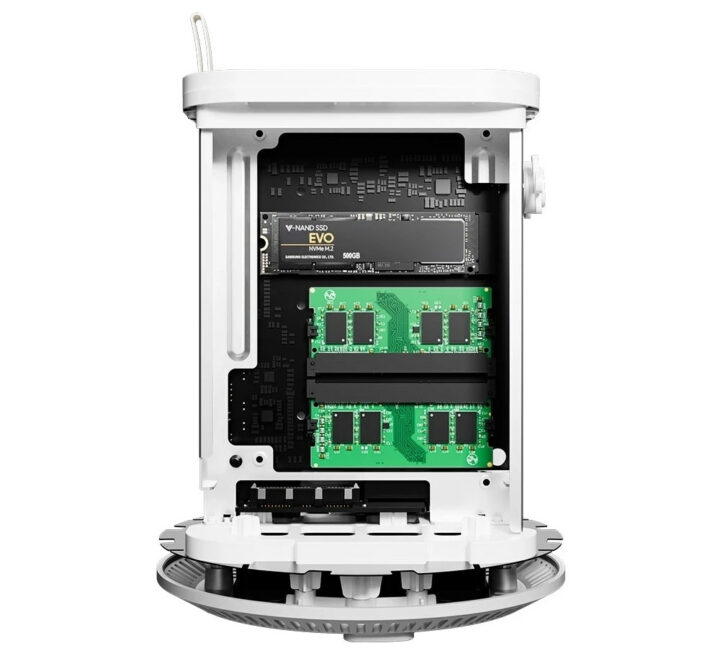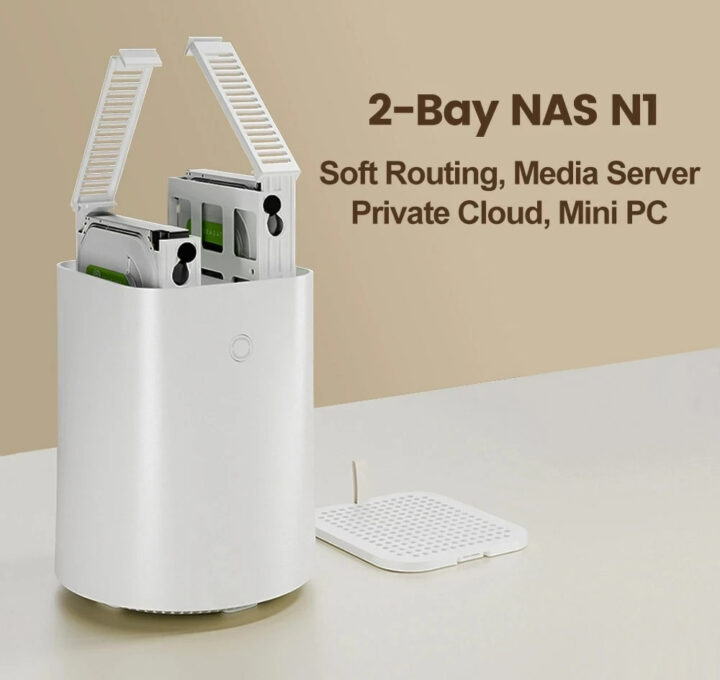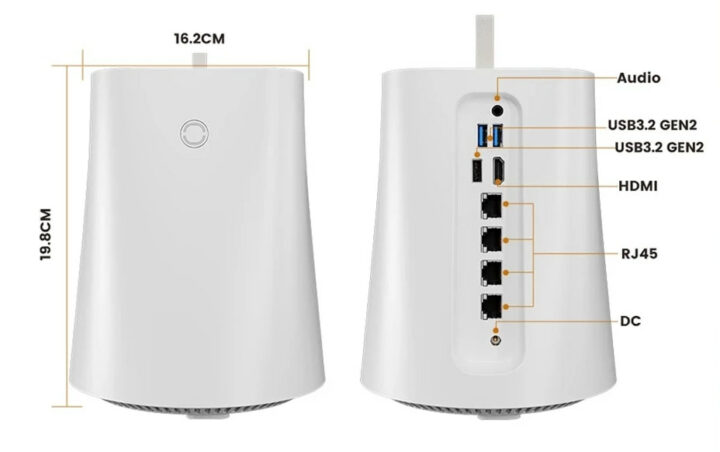Powered by an AMD Athlon Silver 3050e dual-core processor, Topton N1 (aka TP-N1) NAS comes with two SATA bays for 2.5-inch or 3.5-inch drives, as well as four gigabit Ethernet ports.
The system can support up to 32GB RAM, relies on M.2 SSD storage for the OS, and can provide up to 40TB of data storage through the two SATA bays. It is also equipped with an HDMI output port, several USB 3.x/2.0 ports, as well as a 3.5mm audio jack.
Topton N1 specifications:
- SoC – AMD Athlon Silver 3050e dual-core/quad-thread processor @ 1.4 / 2.8 GHz (Turbo) with Radeon Vega 3 graphics @ 1 GHz; TDP: 6W
- System Memory – Up to 32GB DDR4-2400 RAM via two SO-DIMM slots
- Storage
- M.2 2280 socket for a (PCIe 3.0) NVMe SSD
- 2x SATA III bay for 2.5-inch and 3.5-inch driver for a maximum of 40TB data storage (based on currently available HDD)
- Video Output – 1x HDMI port
- Audio – 3.5mm audio jack, digital audio via HDMI
- Networking – 4x Gigabit Ethernet RJ45 ports
- USB – 3x USB 3.2 Gen 2 ports, but one of the ports looks to be a USB 2.0 port instead
- Misc – Power button, BIOS with support for auto power on and Wake-on-LAN
- Power Supply – 19V/3.42A
- Dimensions – 192 x 192 x 198 (H) mm
- Weight – 885 grams
Unless you purchase the barebone model, the company preinstalls Windows 10 Pro on the system but also lists various other Linux operating systems including OpenWrt, CentOS, and Ubuntu, as well as the iKuai soft routing operating system. LEDE is also listed, but I’m not quite sure why, since, as I understand it, the LEDE team has been back to working on the OpenWrt project for a few years now.
Topton says the 6W AMD Athlon Silver 3050e processor (6W) performs about as well as a 15W Celeron N5095 quad-core Jasper Lake processor, but based on data from Netbookcheck.net, it’s mostly true for single-core performance, while the Celeron N5095 performs significantly faster with multi-core workloads, and offers better graphics performance.
 The Topton N1 NAS sells for about $199 barebone, but a full system starts at $242 with 4GB RAM, and a 128GB NVMe SSD, and goes up to $447 with 32GB RAM (dual-channel) and a 1TB SSD. You’d still need to add your own SATA drives.
The Topton N1 NAS sells for about $199 barebone, but a full system starts at $242 with 4GB RAM, and a 128GB NVMe SSD, and goes up to $447 with 32GB RAM (dual-channel) and a 1TB SSD. You’d still need to add your own SATA drives.
Via Liliputing and AndroidPC.es

Jean-Luc started CNX Software in 2010 as a part-time endeavor, before quitting his job as a software engineering manager, and starting to write daily news, and reviews full time later in 2011.
Support CNX Software! Donate via cryptocurrencies, become a Patron on Patreon, or purchase goods on Amazon or Aliexpress







Do you think the 3.5″ bay could hold 2.5″ SSDs?
That’s my understanding that it also supports 2.5-inch drives
If 3.5″ fits then 2.5″ always will fit too (regardless of height). Only issue is to pull those little drives out of the bays so place two tape strips wisely per disk or buy mechanical adapters / carriers for 3.5″ slots.
… and a HDMI interface, so you can also use it as a PC or mediaplayer? If so: nice.
Yes, and the soc supports hdmi-cec. That doesn’t mean this system does, but it MAY work
Yes, that’s some kind of 3-in-1 NAS, mini PC, and router.
And the concept is as stupid as it ever was since smart people realize that a firewall/router should be physically separated from the NAS where your precious data resides.
Would it be possible to achieve something similar with a hypervisor to run two operating systems? For example. OpenWrt could be used to handle the router/firewall, and the main OS for media and NAS with any traffic out of the LAN going through OpenWrt.
If this box would consist of two separate motherboards sure. But if everything runs on the Athlon there needs to be a main OS and some sort of containerization/ virtualization for the router/firewall (PCIe passthrough).
To trust into this you need to ignore reality: VM/container escapes exist. This list is not really exhaustive, CVE-2022-0185 and many others are missing.
Yep. VM or container isolation proves an elusive goal on both AMD and INTEL. Plus, if an SMB port leaks on the Internet the bad guys will come as fast as flees land on ham rotting under the sun.
The history of INTEL SGX enclaves is an equally sobering story.
No wifi, antena jack
😢
So those AliExpress devices that have 4 ethernet could just increase the height of their boxes, use a board with two sata and sell as a Nas too?
With an faster cpu I would buy that immediately – but a passmark of 3000 is very slow…
I bought one – thanks to this post. Wish me luck.
What was your experience with it? What os did you install it?
Thanks in advance!